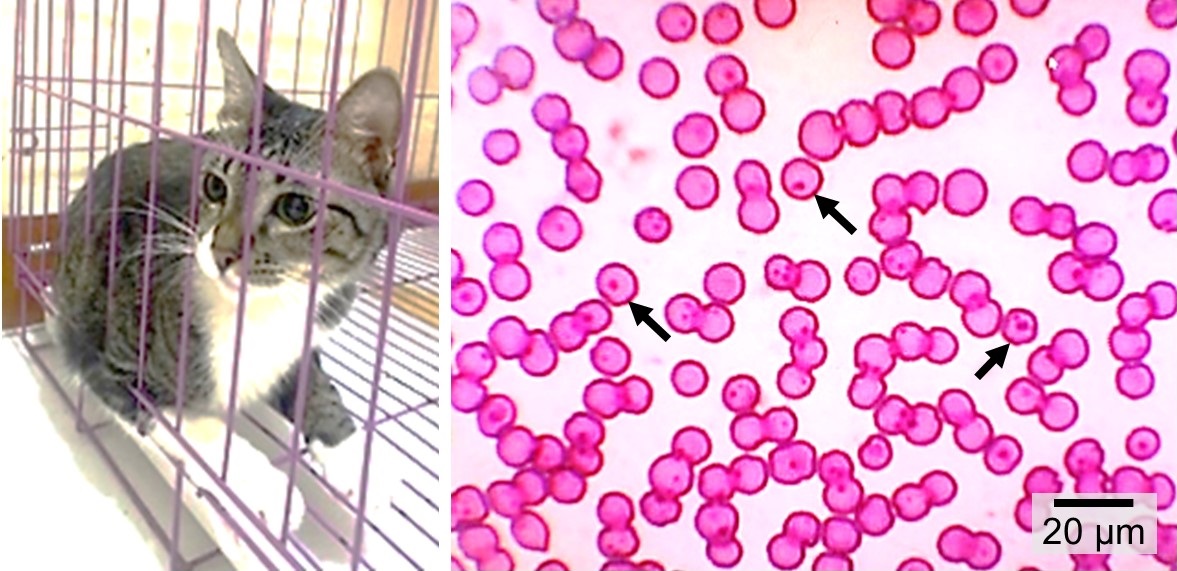Diagnosis and treatment of Anaplasma centrale in a domestic cat at Animal Hospital of Hasanuddin University Makassar
Abstract
Anaplasmosis is a disease caused by obligate gram-negative intracellular bacteria. Anaplasma in cats is generally infected by Anaplasma phagocytophilum, however there are very limited reports of Anaplasma bovis such as Anaplasma marginale and Anaplasma centrale being reported to infect cats. This is the first report of anaplasmosis caused by Anaplasma centrale in cats. The owner brought a one-year-old female domestic cat to the Animal Hospital of Hasanuddin University in Makassar with the condition of not wanting to eat, weak, lethargic, dehydrated, and not defaecating. Diagnosis is carried out through anamnesis, physical examination, clinical examination, and laboratory examination, in the form of haematology and blood smear tests. The results of the examination revealed flea infestation, a blood test identified Anaplasma centrale with characteristics such as the presence of morulae in the middle part of the erythrocytes, and routine blood work showed anaemia which was seen in the MCV parameters increasing and the MCHC values decreased. Treatment consists of administration of antibiotics, anti-inflammatory drugs, and supportive therapy. The cat showed good results, with symptoms starting to disappear and the animal appeared active.
Downloads
References
André MR. 2018. Diversity of Anaplasma and Ehrlichia/Neoehrlichia agents in terrestrial wild carnivores world-wide: implications for human and domestic animal health and wildlife conservation. Frontiers in veterinary science. 5(2018):293-317. https://doi.org/10.3389/fvets.2018.00293 | PMid:30533417 PMCid:PMC6265506
Arsyitahlia N, Suartha IN, Soma IG. 2021. Laporan Kasus: Anaplasmosis pada anjing peranakan Kintamani. Indonesia Medicus Veterinus. 10(2):304-315. https://doi.org/10.19087/imv.2021.10.2.304
Gorna M, Adaszek L, Policht K, Skrzypczak M, Winiarczyk S. 2013. Detection of Anaplasma phagocytophilum in a cat. Veterinární medicína. 58(1):39-43. https://doi.org/10.17221/6655-VETMED
Makgabo SM, Brayton KA, Oosthuizen MC, Collins NE. 2023. Unravelling the diversity of Anaplasma species circulating in selected African wildlife hosts by targeted 16S microbiome analysis. Current Research in Microbial Sciences. 5(2023):100198. https://doi.org/10.1016/j.crmicr.2023.100198 | PMid:37675244 PMCid:PMC10477809
Oliveira AC, Luz MF, Granada S, Vilhena H, Nachum-Biala Y, Lopes AP, Cardoso L, Baneth G. 2018. Molecular detection of Anaplasma bovis, Ehrlichia canis and Hepatozoon felis in cats from Luanda, Angola. Parasites & vectors. 11(1):1-6. https://doi.org/10.1186/s13071-018-2767-y | PMid:29554946 PMCid:PMC5859530
Priyanka M, Dhanalakshmi H, Rakesh RL, Thimmareddy PM, Narayana Bhat M. 2017. Monocytic anaplasmosis in a cow: a case report. Journal of Parasitic Diseases. 41(2017):687-688. https://doi.org/10.1007/s12639-016-0867-1 | PMid:28848260 PMCid:PMC5555913
Putra WG, Widyastuti SK, Batan IW. 2019. Laporan Kasus: Anaplasmosis dan Ehrlichiosis pada Anjing Kampung di Denpasar, Bali. Indonesia Medicus Veterinus. 8(4):502-512.
Sykes JE. 2013. Canine and Feline Infectious Diseases. Missouri: Elsevier.
Underwood WJ, Blauwiekel R, Delano ML, Gillesby R, Mischler SA, Schoell A. 2015. Biology and Diseases of Ruminants (Sheep, Goats, and Cattle), in: Laboratory Animal Medicine. Elsevier, pp. 623-694.
https://doi.org/10.1016/B978-0-12-409527-4.00015-8 | PMCid:PMC7149867
Wardani PI, Putriningsih PA, Soma IG. 2023. Dermatitis due to Sarcoptes scabiei and Rhipicephalus sanguineus accompanied by anaplasmosis in Shih-tzu mixed dog. Veterinary Science and Medicine Journal. 5(10):290-302. https://doi.org/10.24843/vsmj.2023.v5.i10.p08
Yancey CB, Diniz PP, Breitschwerdt EB, Hegarty BC, Wiesen C, Qurollo BA. 2018. Doxycycline treatment efficacy in dogs with naturally occurring Anaplasma phagocytophilum infection. Journal of Small Animal Practice. 59(5):286-293. https://doi.org/10.1111/jsap.12799 | PMid:29280490

Copyright (c) 2023 CC-BY-SA

This work is licensed under a Creative Commons Attribution-ShareAlike 4.0 International License.
Authors who publish with this journal agree to the following terms:
1. Authors retain copyright and grant the journal right of first publication with the work simultaneously licensed under a Creative Commons Attribution License that allows others to share the work with an acknowledgement of the work's authorship and initial publication in this journal.
2. Authors are able to enter into separate, additional contractual arrangements for the non-exclusive distribution of the journal's published version of the work (e.g., post it to an institutional repository or publish it in a book), with an acknowledgement of its initial publication in this journal.
3. Authors are permitted and encouraged to post their work online (e.g., in institutional repositories or on their website) prior to and during the submission process, as it can lead to productive exchanges, as well as earlier and greater citation of published work (See The Effect of Open Access).

.jpg)














